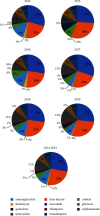Molecular Epidemiology of Escherichia coli Resistant to Carbapenems, Fluoroquinolones, and Aminoglycosides Isolated from One of the Largest Hospitals in Vietnam in 2014-2019
- PMID: 38328340
- PMCID: PMC10849806
- DOI: 10.1155/2024/2711353
Molecular Epidemiology of Escherichia coli Resistant to Carbapenems, Fluoroquinolones, and Aminoglycosides Isolated from One of the Largest Hospitals in Vietnam in 2014-2019
Abstract
Introduction: Multidrug-resistant (MDR) Gram-negative bacilli including carbapenem-resistant Gram-negative Enterobacteriaceae (CRE) threaten global health. Little is known, however, about the distribution of antimicrobial resistance genes in MDR isolated from patients in Vietnamese hospitals. In this study, we collected MDR Escherichia coli, defined as E. coli resistance against all fluoroquinolones, aminoglycosides, and carbapenems.
Aim: This study was designed to clarify the molecular epidemiology of Escherichia coli isolates resistant to carbapenems, fluoroquinolones, and aminoglycosides isolated from patients admitted to one of the largest hospitals in Vietnam in 2014-2019 based on both whole-genome sequencing (WGS) and phenotypic data. Methodology. Sixty-seven Vietnamese isolates screened by drug resistance by the disk test were subjected to WGS, and their sequences were analyzed to determine their multilocus sequence type (MLST), O-types, H-types, distribution of drug resistance genes, plasmid types, pathogenicity islands (PIs), virulence factor distribution, and phylogenetic evolution using the WGS data.
Results: Among the STs detected, ST410 was relatively dominant. Dominant O-types and H-types were O102 and H9 and showed some links, such as those between O102 and H8. The most dominant plasmid type and carbapenemase type were 4 and NDM-5, respectively. MLST, O-types, H-types, plasmid types, and types of carbapenemases were very heterogeneous among the isolates, with no clear correlation between them. Dominant plasmid type carrying drug resistance gene was IncQ1_1. The percentage of isolates positive for drug resistance genes, such as anti-beta-lactams and aminoglycosides, was relatively high because the isolates screened were resistant to carbapenems, fluoroquinolones, and aminoglycosides.
Conclusions: MDR E. coli isolates isolated at a high-volume Vietnamese hospital were very heterogeneous, suggesting that they were acquired from different sources, including nosocomial infection, animals, and water. Eradication of MDR E. coli from hospitals and other clinical environments is very challenging because a single measure may be ineffective.
Copyright © 2024 Tohru Miyoshi-Akiyama et al.
Conflict of interest statement
The authors declare that they have no conflicts of interest.
Figures


References
-
- Malchione M. D., Torres L. M., Hartley D. M., Koch M., Goodman J. L. Carbapenem and colistin resistance in Enterobacteriaceae in Southeast Asia: review and mapping of emerging and overlapping challenges. International Journal of Antimicrobial Agents . 2019;54(4):381–399. doi: 10.1016/j.ijantimicag.2019.07.019. - DOI - PubMed
-
- Van T. T., Chin J., Chapman T., Tran L. T., Coloe P. J. Safety of raw meat and shellfish in Vietnam: an analysis of Escherichia coli isolations for antibiotic resistance and virulence genes. International Journal of Food Microbiology . 2008;124(3):217–223. doi: 10.1016/j.ijfoodmicro.2008.03.029. - DOI - PubMed
LinkOut - more resources
Full Text Sources

